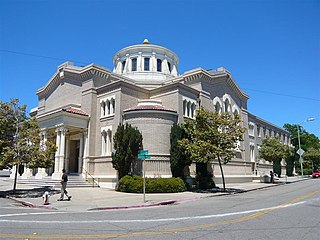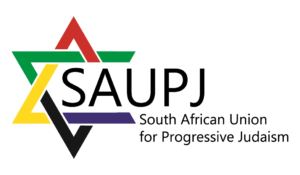
Mount Zion Temple is a Reform Jewish synagogue located at 1300 Summit Avenue, in St. Paul, Minnesota, in the United States. Founded in 1856 as Mount Zion Hebrew Association, it was the first Jewish congregation in Minnesota. The congregation was formed before the statehood of Minnesota in 1858.

Congregation Baith Israel Anshei Emes, more commonly known as the Kane Street Synagogue, is an egalitarian Conservative synagogue located at 236 Kane Street in Cobble Hill, Brooklyn, New York City, New York, in the United States. It is currently the oldest continuously operating synagogue in Brooklyn.

Congregation Beth Elohim, also known as the Garfield Temple and the Eighth Avenue Temple, is a Reform Jewish congregation and historic synagogue located at 274 Garfield Place and Eighth Avenue, in the Park Slope neighborhood of Brooklyn in New York City, New York, in the United States.
Temple Shalom of Northwest Arkansas is an unaffiliated Jewish congregation and synagogue, located at 699 North Sang Avenue, in the Fayetteville area of Arkansas, in the United States. The small, mixed-denomination congregation is affiliated with the Union for Reform Judaism, yet it supports a variety of activities and services for Jews of all backgrounds.

Temple Sinai is a Reform synagogue located at 2808 Summit Street in Oakland, California, United States. Founded in 1875, it is the oldest Jewish congregation in the East San Francisco Bay region.
Beth Israel Congregation is a Reform Jewish congregation and synagogue located at 5315 Old Canton Road in Jackson, Mississippi, in the United States. Organized in 1860 by Jews of German background, it is the only Jewish synagogue in Jackson. Beth Israel built the first synagogue in Mississippi in 1867, and, after it burned down, its 1874 replacement was at one time the oldest religious building in Jackson.

Congregation Beth Israel is a Jewish congregation located at 10460 North 56th Street in Scottsdale, Arizona. Formally incorporated in 1920, it affiliated with the Reform Judaism in 1935.
Temple Beth Israel is a Reform Jewish synagogue located at One Bowman Street in Plattsburgh, Clinton County, New York, in the United States. Established in 1861, it initially served Plattsburgh's Jewish population and itinerant Jewish tradesmen in the region. After worshiping in temporary locations, the congregation acquired its first permanent home on Oak Street in 1866. Beth Israel adopted Reform services in 1910, and joined the Union for Reform Judaism in 1913.

Congregation Beth Israel is a Modern Orthodox synagogue located at 4004 West Esplanade Avenue, Metairie, a suburb of New Orleans, Louisiana, in the United States.
Congregation Beth Israel Judea is a Reform synagogue located at 625 Brotherhood Way in San Francisco, California. It is the result of the merger of the Conservative Congregation Beth Israel and the Reform Temple Judea.
Temple Israel is the oldest synagogue in Columbus, Ohio, and a founding member of the Union for Reform Judaism. Formed as early as 1846 as the Orthodox Bene Jeshurun congregation, its first religious leader was Simon Lazarus, a clothing merchant who founded what would become Lazarus department stores.

Temple Israel is a Reform congregation located at 130 Riverside Drive in Dayton, Ohio. Formed in 1850, it incorporated as "Kehillah Kodesh B'nai Yeshurun" in 1854. After meeting in rented quarters, the congregation purchased its first synagogue building, a former Baptist church at 4th and Jefferson, in 1863. Strongly influenced by Rabbi Isaac Mayer Wise, it rapidly modernized its services, and, in 1873, was a founding member of the Union for Reform Judaism.

Temple Israel is a Reform Jewish|Reform Jewish congregation and synagogue located at 1376 East Massey Road, in Memphis, Tennessee, in the United States. It is the only Reform synagogue in Memphis, the oldest and largest Jewish congregation in Tennessee, and one of the largest Reform congregations in the U.S. It was founded in 1853 by mostly German Jews as Congregation B'nai Israel. Led initially by cantors, in 1858 it hired its first rabbi, Jacob Peres, and leased its first building, which it renovated and eventually purchased.
Har Sinai – Oheb Shalom Congregation is a Reform Jewish congregation and synagogue located at 7310 Park Heights Avenue, in Pikesville, Baltimore County, Maryland, in the United States. Established in 1842 in Baltimore and known as Har Sinai Congregation, and in 1853 near Camden Yards as Temple Oheb Shalom, the two congregations merged in 2019 and is the oldest Reform congregation in the United States that has used the same prayer rite since its inception.

Temple Israel of the City of New York is a Reform Jewish congregation and synagogue located at 112 East 75th Street, on the Upper East Side of Manhattan in New York City, New York, in the United States. The congregation was incorporated by German Jews in 1873.
Temple Israel is the oldest of eleven Progressive synagogues in South Africa. It is a provincial heritage site, built in the Art Deco style by architect Hermann Kallenbach. It is located in the Johannesburg suburb of Hillbrow. It is an affiliate of the South African Union for Progressive Judaism (SAUPJ), which is part of the World Union for Progressive Judaism (WUPJ).

Temple B'nai Israel is a Reform Jewish congregation and synagogue located at 4901 North Pennsylvania, Oklahoma City, Oklahoma, in the United States. The congregation is the oldest active Jewish congregation in Oklahoma.

The South African Union for Progressive Judaism (SAUPJ) is an affiliate of the World Union for Progressive Judaism and supports 11 progressive congregations. Rabbi Moses Cyrus Weiler, a founder of Reform Judaism in the country, led the country's first Reform synagogue, Temple Israel in Hillbrow, Johannesburg. Weiler is credited with growing the movement, to represent 15-17% of South African Jewry and establishing 25 congregations in the country. A 2020 joint study by the Institute for Jewish Policy Research and the University of Cape Town showed that 12% of Jews identified as Progressive and that in relative terms the progressive strands are increasing after falling to 7% in 1998 and 2005 studies. In Johannesburg, the community accounts for 7% of the city's Jewry, rising to 18% in Cape Town and 25% in Durban.
Temple Israel, also known as the Cape Town Progressive Jewish Congregation (CTPJC), is a Progressive Jewish congregation in Cape Town, with three centres in Green Point, Wynberg and Milnerton. As three centres combined, they are the largest Progressive congregation in South Africa, and the second largest Jewish congregation in Cape Town after Marais Road Shul in Sea Point. The congregation first started in Green Point in 1944, eight years after South Africa's first progressive synagogue, also Temple Israel, opened in Hillbrow in Johannesburg. The Cape Town congregation caters to over 3000 Progressive Jews in the city. The congregation is an affiliate of the South African Union for Progressive Judaism, which is part of the World Union for Progressive Judaism (WUPJ). The congregation represents around 18% of Cape Town Jewry.














